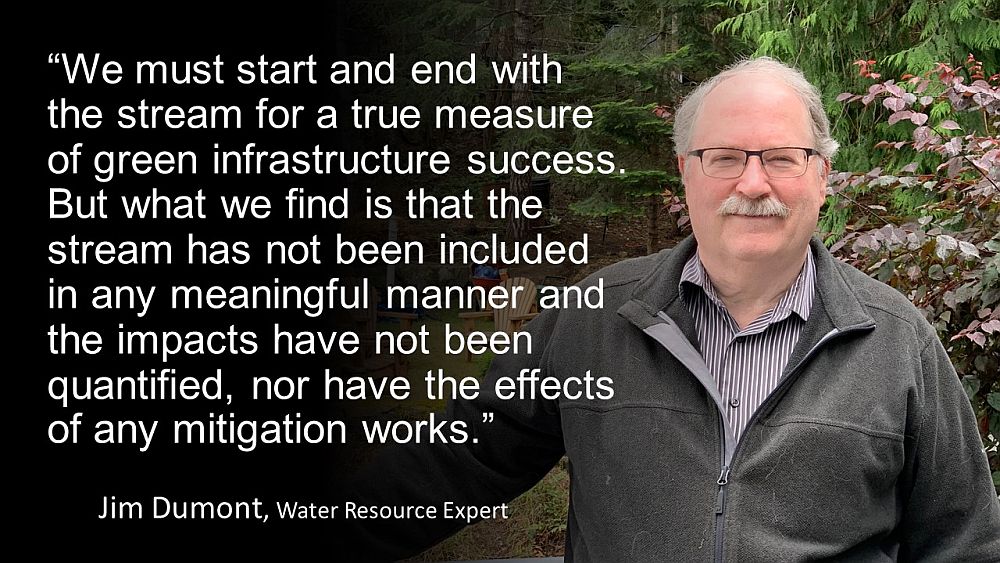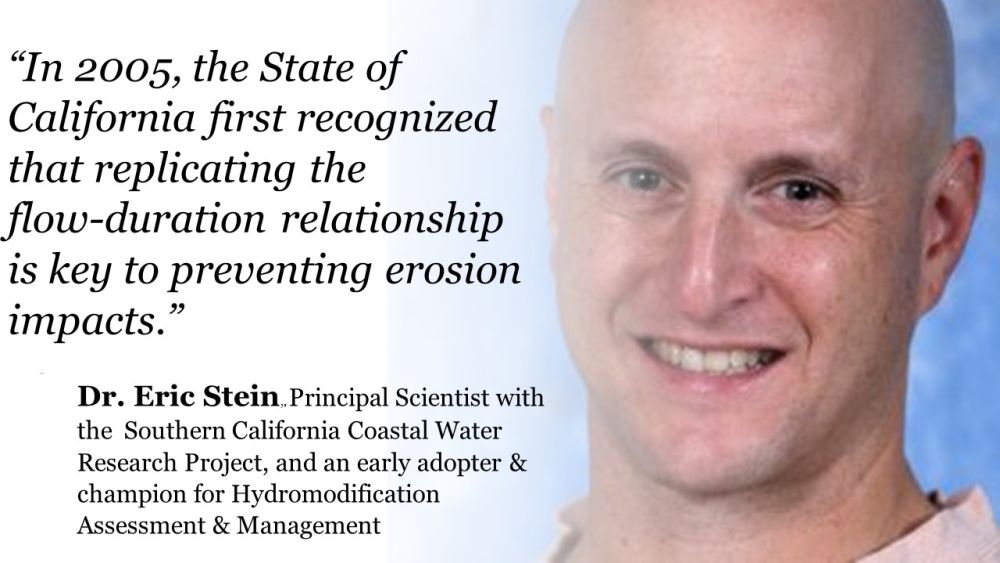REALITY CHECK FOR ADAPTING TO A CHANGING SEASONAL WATER BALANCE: “We must start and end with the stream for a true measure of green infrastructure success. Maintain stream flow duration to protect against stream erosion and flooding,” stated Jim Dumont, rainwater management thought leader (October 2023)
Note to Reader:
Published by the Partnership for Water Sustainability in British Columbia, Waterbucket eNews celebrates the leadership of individuals and organizations who are guided by the Living Water Smart vision. The edition published on October 3, 2023 featured the clear thinking and innovation of Jim Dumont in evolving the Water Balance Methodology to the point where it underpins a risk reduction approach to protecting streams in a changing climate.


STORY BEHIND THE STORY: Why have the practitioners of Rainwater Management in British Columbia fallen behind? – an essay by Jim Dumont
“So, why have the practitioners of Rainwater Management in British Columbia fallen behind practitioners in Washington State, Oregon and California in protecting streams? In answering this question, one must understand how we arrived at this situation and then it will be easy to see a path forward,” states Jim Dumont.
“At about the turn of the 21st century a catastrophic loss of salmon stocks occurred along the west coast. This resulted in job losses and additional stress was imposed on the venerable Orca.”
“Public sentiment and resources were focused on finding the causes and in providing solutions. The public demanded answers and a collaboration of researchers along the west coast added to our scientific knowledge.”

What we learned from the research in biology, geomorphology and engineering

“Research in geomorphology, the study of stream formation identified that rare floods were not the cause of all changes in a stream forms. It was found that major changes of stream form occurred during floods with a return period as small as a 2-year return period.”

“Engineering research into stream erosion directly linked to friction (tractive force) and easily found that any increase in discharge duration would increase stream erosion. Additionally, development was found to increase the duration of erosion causing discharges in headwater streams, even with the inclusion of stormwater detention ponds.”

As a response to the “salmon crisis”, the Province of BC adopted the Water Balance Methodology to protect streams and property
“In 2002, the provincial government released Stormwater Planning: A Guidebook for British Columbia. The Guidebook demonstrated that changes in rainwater management could be made at a site level by establishing water balance performance targets.”
“This led to significant changes to development practice with the inclusion of rainwater capture and infiltration systems with the sole objective to reduce surface runoff.”

“Reliance was paced on the assumption that infiltration of rainwater would somehow mitigate development impacts without additional research or analysis that included the headwater streams.”
“In practice, this approach follows that used in the more industrialized areas of the eastern portions of the continent where water quality is the most important factor in implementing rainwater management.”

Meanwhile, in all three states on the United States West Coast
“California, Washington, and Oregon progressed further by encompassing the lessons of the three areas of research. In 2008 the California Water Resources Control Board concluded negotiations with the US Environmental Protection Agency and was able to include stream discharge duration in all new stormwater planning and designs.”
“This provided a unique focus based upon the needs along the west coast to mitigate changes in streams while providing flood protection. The Oregon Department of Transportation (DOT) quickly followed with stormwater drainage requirements that included duration of discharges in their projects.”
“Washington Ecology took a bit longer. After introducing the concept of discharge duration in 2001 they formulated an agreement with the US-EPA in 2012 that discharge duration would be included in stormwater planning and designs.”

British Columbia’s provincial government informed local governments about the methodology for “stream discharge duration”
“So, what happened in British Columbia?”
“Why did BC local governments not follow through and learn from the example of the three states along the west coast? In BC, in parallel with the US states we did continue to research the problems and to identify practical improvements to our practice of rainwater management.”
“Beyond the Guidebook 2007: Context for Rainwater Management and Green Infrastructure in British Columbia laid out the basis for an evolution in the Water Balance Methodology to include flow duration.”
“The Ministry of Community Development then sent out a circular to all Municipal and Regional District Chief Administrative Officers, Engineers and Planners regarding the Beyond the Guidebook provincial initiative.”

“For many practitioners it is far easier to simply add ground infiltration measures to existing drainage practices without any updating of regulations and drainage bylaws. This approach has a bias on pollution control through diversion away from the stream and into the ground, with more being better.”
“The stream has not been included in any meaningful manner and the impacts have not been quantified, nor have the effects of any mitigation works.”

What do we need?
“If the stream and ultimately the salmon and Orca are keys in our objectives then we must bring the stream back into our planning and design processes as did California, Washington, and Oregon.”
“We must also update the regulations and bylaws to include flow durations in the stream. This approach has been well researched and documented by those regulators on the US west coast and by the Partnership for Water Sustainability in British Columbia.”

Living Water Smart in British Columbia Series
To download a copy of the foregoing resource as a PDF document for your records and/or sharing, click on Living Water Smart in British Columbia: A window into the green infrastructure journey in the Metro Vancouver region.


